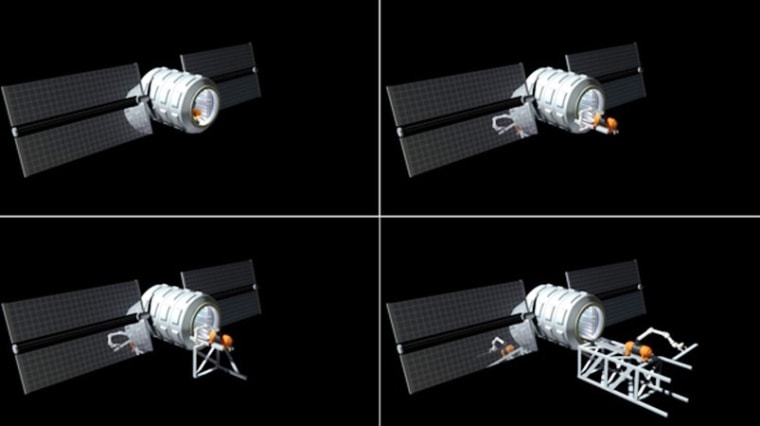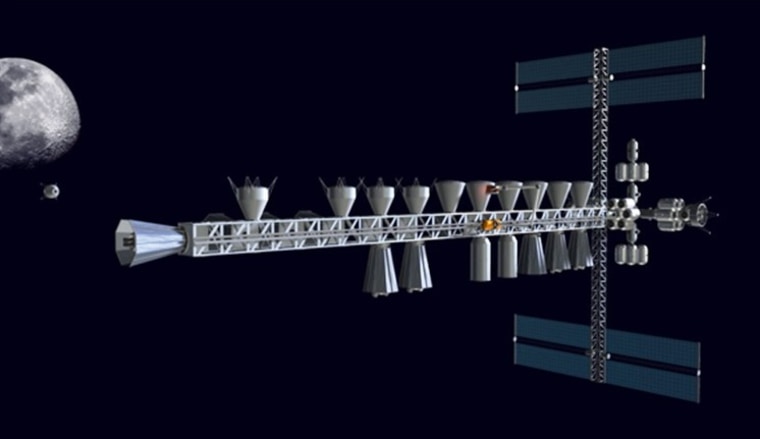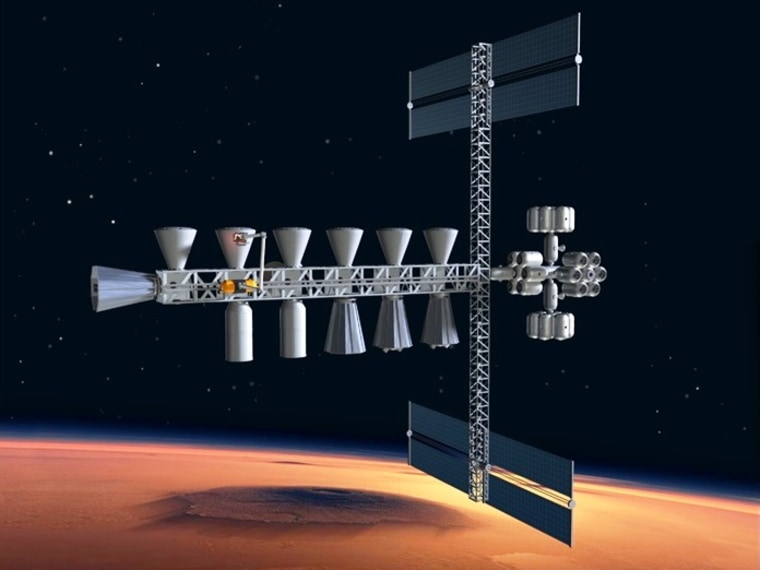While NASA works on a multibillion-dollar, decades-long space exploration plan that relies on monster rockets, an informal cadre of engineers is laying out a different vision that would take advantage of cheaper, smaller spacecraft that can fuel up at "truck stops" along the way.
Right now, the alternate vision, known as the "Stairway to Mars," is little more than an engineering exercise. But the plan's proponents on the Space Development Steering Committee say their scenario for Mars missions in the 2030s may have a better chance of becoming a reality than NASA's scenario.
They point to President George W. Bush's Constellation program, which called for sending astronauts to the moon by 2020, as a cautionary example.
"I don't see that the path we're on here is any more sustainable than Constellation was when it was cancelled at the start of the Obama administration," said Bruce Pittman, who is chairman of the Commercial Space Group at the American Institute of Aeronautics and Astronautics, as well as senior vice president and chief operating officer for the National Space Society.
Pittman also works as a contractor at NASA's Ames Research Center, specializing in commercial spaceflight, but he emphasized that he wasn't speaking on behalf of the space agency. Neither was Wayne Hale, the retired manager of the space shuttle program, when he said during this week's Wernher von Braun Symposium in Alabama that NASA's current plan was "fragile in the political and financial maelstrom that is Washington."
That fragility is especially in evidence this month, with 97 percent of the space agency's workforce furloughed due to the federal government shutdown.
Follow the money
NASA's long-term exploration plan calls for the development of a new heavy-lift rocket known as the Space Launch System and a new spaceship called the Orion, which would travel to a near-Earth asteroid in the 2020s and to Mars and its moons in the 2030s. The program's cost leading up to the first crewed flight has been estimated at $30 billion to $40 billion. Once the SLS enters service, each flight is expected to cost billions more.
"We can accomplish this vision technically, but the central question still remains: 'Where does the money come from?'" said Hale, who is highly respected in the spaceflight community. He told his Huntsville audience that NASA's plan was "not sustainable," and that "it's time to try new strategies."
Pittman said the "Stairway to Mars" scenario would take advantage of the model set by NASA for commercial resupply of the International Space Station. In the past year, two types of commercial spaceships — SpaceX's Dragon and Orbital Sciences Corp.'s Cygnus — have made cargo deliveries to the space station.
SpaceX is already well into the development of a crew-capable version of the Dragon (known as the DragonRider), as well as a heavy-lift rocket known as the Falcon Heavy. Meanwhile, Nevada-based Bigelow Aerospace is building an inflatable test module for the space station.
"If you have a Falcon Heavy, and you have a Dragon, and you have a Bigelow module, then all of a sudden, life gets interesting," Pittman told NBC News. "It changes the whole equation here."
Access to Mars
A potential scenario has been fleshed out by John Strickland, a computer programmer who's on the National Space Society's board of directors. He's been fine-tuning his "Access to Mars" scenario for several years. It would employ Falcon Heavy rockets, space refueling depots that he calls "truck stops," and spacecraft like the Dragon or the Cygnus to get crews from Earth to the Red Planet.
"The way you do it is by having a fully reusable space transportation system," Strickland told NBC News.



The concept for an off-Earth rocket refueling depot isn't new: It was one of the technologies suggested by an independent panel that reviewed the space program for the Obama administration. But NASA officials have said the Space Launch System would get humans beyond Earth orbit more quickly.
"We could sit back and wait for a commercial entity like SpaceX to develop a human-rated Falcon 9 and for someone to develop in-space propellant storage depots," NASA Administrator Charles Bolden told a space conference in May. "We won’t get to an asteroid in 2021, and we definitely won’t get to Mars in the 2030s, in my estimation."
Strickland takes issue with Bolden's view. "He's basically saying what he's told to say," Strickland said. He and others who are working on the alternate scenario worry instead that the Space Launch System could eventually wind up on the dustbin of history — alongside Constellation, President George H.W. Bush's Space Exploration Initiative and the recommendations of the Nixon administration's Space Task Group.
Strickland said the alternate scenario could lead to the establishment of a base on Mars in the 2030s, at a cost of "tens of billions of dollars instead of hundreds of billions." But like most of the claims that are made for grand visions, Strickland's cost and time estimates are subject to debate.
Why go?
The way Pittman sees it, the first task is to lay out the reasons for beyond-Earth-orbit spaceflight — whether it's to learn about life on Mars, or to learn how to live and thrive on another world, or to extract resources for use on Earth or in space.
"What comes after exploration? What's next?" Pittman asked. "If there's going to be the development of a commercial space economy, whatever it is, shouldn't you do your exploration to prepare a path for what's going to come next?"
Such soul-searching could help determine what it's worth to go beyond Earth orbit — and determine which commercial ventures might get involved. That doesn't mean that NASA becomes irrelevant. In fact, Pittman argues that the space agency is essential to commercial success in space.
"The government can provide a very useful function to coordinate and synthesize all this so it plays well together," he said. "That's what leadership is all about. ... Unless and until you get the government on board, it's really tough to make progress. We're trying to get people to have this dialogue. To me, there's too much talking, and not enough listening going on.
"We're spending real dollars, and there's an opportunity here," Pittman said. "But it's not going to last forever."
Update for 4:25 p.m. ET Oct. 13: In a follow-up email, Strickland says his mission scenario is similar to but not exactly the same as Pittman's. Costs and timelines may vary due to differences in mission scope. He also sends along more details about the potential applications for space infrastructure:
"Ninety percent of the mass for my Mars mission plan (including propellant) could and probably would be launched by smaller rockets, instead of the SLS, whichever is cheaper per pound to orbit, such as Falcon 9R or Falcon Heavy. However, to launch the Ferry vehicles, which are only 30 tons dry mass, but 14 meters wide at the base, we need a launcher the same diameter as the Saturn V, or 33 feet across. Right now, no one has such a launcher on the drawing board."Of course, any on the government's drawing board would be expendable, and thus far too expensive to use for 10 or 15 ferry launches. The SLS could launch a lander or ferry with a smaller base area ... and thus it would not be able to land nearly as much cargo on Mars. The wider the ferry, the more mass it can land."The bigger picture besides the focus on Mars is that our step-by-step approach opens up avenues of easy access to many other space goals, such as the moon, asteroids, and building space-based solar power. The latter is only now becoming feasible as launch costs start to significantly decline for the first time in history...."
More about commercial space ventures:
- Private spaceflight study shoots for the moon
- Asteroid miners get financial boost from NASA
- Thousands pay for a chance to take one-way Mars trip
Alan Boyle is NBCNews.com's science editor. Connect with the Cosmic Log community by "liking" the NBC News Science Facebook page, following @b0yle on Twitter and adding +Alan Boyle to your Google+ circles. To keep up with NBCNews.com's stories about science and space, sign up for the Tech & Science newsletter, delivered to your email in-box every weekday. You can also check out "The Case for Pluto," my book about the controversial dwarf planet and the search for new worlds.